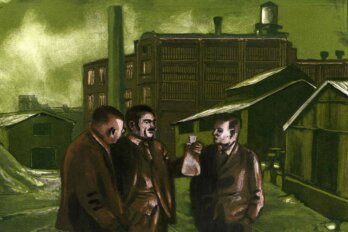It’s 5 a.m. in High Park—400 acres of forest, ponds, and paths in Toronto’s West End—and a procession is weaving through the budding trees, silent except for binoculars rustling against jackets. A few people wear headlamps to light the way. Tired feet drag along the ground. The air is still and cold, heavy with dew, but as the sky lightens, the trees begin to thrum, rising with the sun into a crescendo of birdsong.
On the first Sunday of May, the High Park Nature Centre celebrated International Dawn Chorus Day with its inaugural early morning walk through the woods. Allegedly begun in the 1980s by an eccentric British broadcaster who demanded that people arrive at 4 a.m. for his birthday party, the event retains an air of peculiarity. Who, after all, would wake up this early just to hear a bunch of birds also wake up—especially downtown in Canada’s most populated city?
“Toronto’s a natural place for a lot of birds to come to,” says Emily Rondel, Toronto projects coordinator for Bird Studies Canada. She looks unlike a stereotypical birder: her socks aren’t up to her knees, her eyes are not obscured by thick glasses, and, at thirty-one, she is about twenty years younger than the median age. But when the subject turns to birds, her voice rings with enthusiasm, despite the early hour. “There are more than 320 species on the Toronto bird list”—those that have been sighted—“and more than 200 species breed here.”
As the sounds of the chorus dwindle, a call like a small sneeze alerts Rondel to the presence of a hard-to-spot migrant songbird. Not much bigger than a hummingbird, a blue-gray gnatcatcher sits on a branch, impossibly still. Gnatcatchers build tiny nests high up in large, mature trees, and they are rarely seen as they flit through the foliage. This one stays put for nearly fifteen minutes, almost cooperatively as people take turns marveling at a bird most of them have never heard of.
Toronto is both a home for birds and a crucial stopover between their wintering and breeding grounds. The city’s 10 million trees and ample supply of fresh water not only provide living space for urban wildlife—from coyotes to cottontail rabbits—they also process a quarter of the city’s industrial emissions. (Toronto hopes to increase tree canopy coverage from the current 28 percent to 40 percent by 2057.)
The city also acts as a kind of funnel for migratory birds. “It’s actually on a migration flyway”—like an avian superhighway, explains Rondel. Even though there are hundreds of species that migrate north into Canada in the spring, there are only five or six of these flyways in North America, where birds stream back and forth as the seasons change. Toronto lies at the confluence of two.
The flyways are humming during the spring and fall, with birds migrating over different times and distances. The American woodcock, for example, travels only from the southern United States, but arrives in Toronto around the same time as the chimney swift, which overwinters in Ecuador and Colombia. (To be fair, the American woodcock looks as aerodynamic as an avocado.)
After the walk, everyone convenes in the terrarium-lined walls of the Nature Centre, milling around, drinking coffee, and comparing notes. This year, the migration for all species has been slow. “We mostly had resident birds today: blackcap chickadees, northern cardinals, blue jays,” says Rondel—with a few exceptions. She takes out her phone and opens up a special birding app, which begins playing the common loon’s familiar tremolo. The call attracts the attention of a nearby birder, a grey-haired woman who closes her eyes in peaceful rapture. “When I first heard the loon today, I couldn’t believe my ears,” she says. “I thought, you know, I’m just delusional, I’m just hallucinating.”
This kind of enthusiasm is endemic to regular birders, but it can be difficult to attract new recruits to the hobby. Jon Hayes, the High Park Nature Centre’s program coordinator, was surprised and pleased when he arrived to find over seventy people gathered outside for the walk. He’s already planning for next year.
“I woke up at 6 a.m. on Tuesday and I panicked, because I could already hear the robins and the sun was coming up,” he explains. “I thought, ‘5 is way too late! Next year, we do it at 4!’ ”
The diversity of the turnout this year is also encouraging. “Traditionally, birders fit one demographic: old white people,” says Rondel. Part of her job is to draw a different crowd to these events. “I’m a first-generation Canadian, neither of my parents speak English as their first language, and I grew up in a high rise in downtown Toronto,” she says. “I want an eight-year-old version of myself to feel like she can participate.”
Events like these not only foster a connection between city-dwellers and their urban wild space, but the engagement is vital for the birds. Ornithology relies heavily on citizen science, or enlisting dedicated amateurs in research. Bird Studies Canada helps run the Christmas Bird Count, a hemisphere-wide endeavour and the oldest citizen science project in North America. Biologists in several countries rely on the data collected to answer important questions about bird movement and conservation. “Citizen scientists deliver really good quality information,” says Rondel, “but people only become citizen scientists if they’ve had exposure to nature education.” But still, some people have no idea what’s in their own backyard.
Attending a dawn walk is a good start, and Rondel is hopeful that the more people learn, the more they will be interested. “When you start birding, step one is overwhelming: you realize there are so many birds and so many songs and the males and females all look different. Step two is magic: that’s the golden time. Every bird you see is new, but you’re understanding what you see.”
It’s almost 6:30 a.m. and people are filing out of the Nature Centre, comparing highlights. The blue-gray gnatcatcher, it is agreed, was especially miraculous. “I think I saw a woodpecker,” a young girl announces. “Congratulations!” says Rondel. “Thanks for coming!”
By now, the sun has risen and the chorus has subsided, and early morning traffic hums and mingles with the last of the birdsong.






